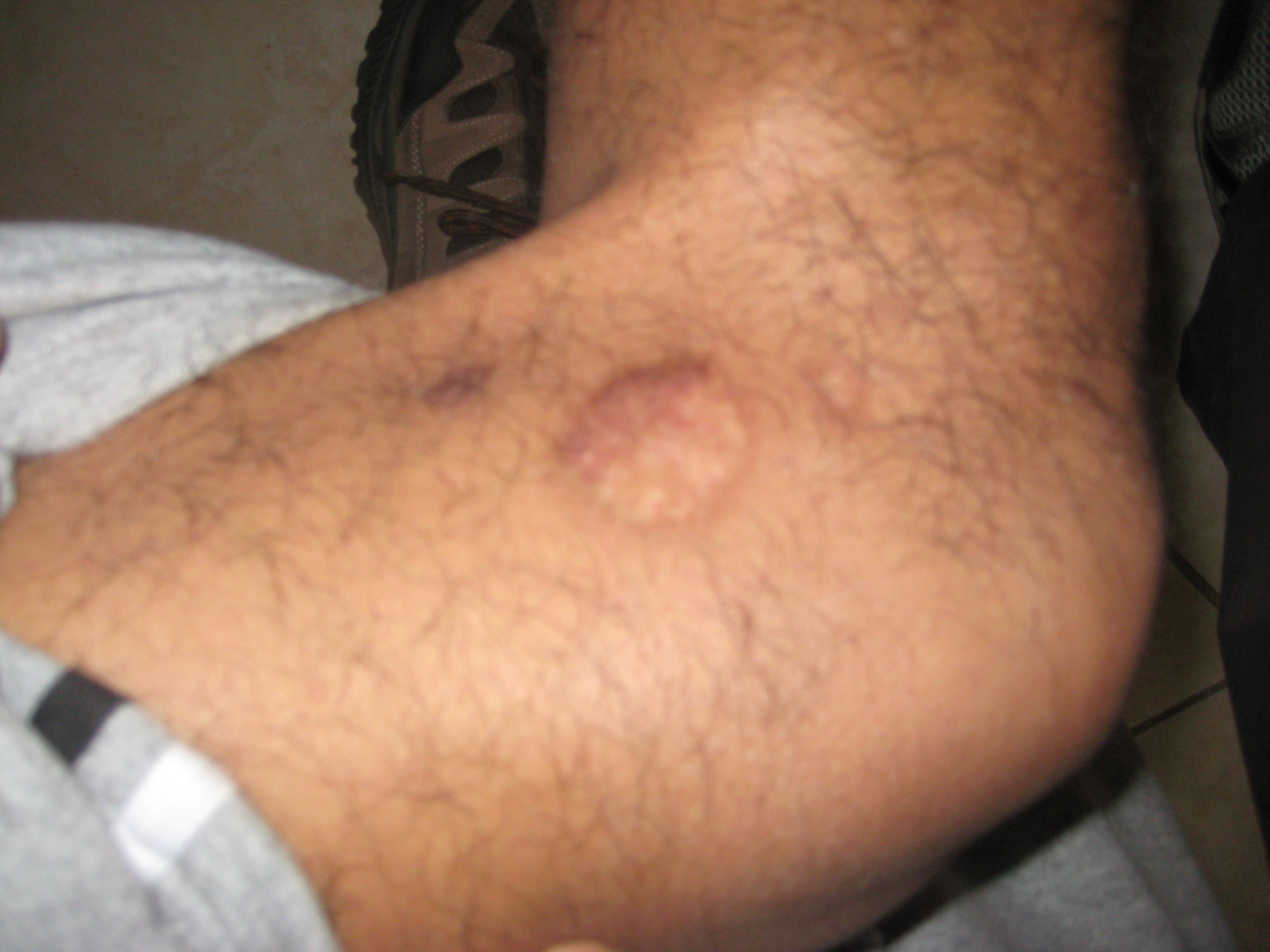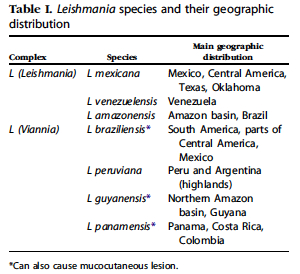HPI: 29 yo male presents to the clinic with a skin rash on his left leg that appeared abruptly over the past week. The lesion is not painful, but appears to be getting worse. He notes that he has had a very similar skin lesion a few years ago, for which he received treatment for a month, and then it resolved. He does not remember the name of the treatment/medication. He denies any other symptoms including fevers, chills, or nausea/vomiting.
PMHx, PSHx, FHx, SHx: No significant past medical history. Of note, he recently arrived to Cuzco from Puerto Maldonado (a village near the Peruvian jungle).
Physical Exam: Unremarkable except for the skin lesions seen below, both on the left leg.

Skin lesion located on the inner calf of the left leg. Notice the circular pattern and some crusting in the middle. Some describe these lesions as a "pizza pie" lesion.

Similar lesion as the other, also on the same leg, but the patient reports that he had this lesion about a year ago for which he received treatment, and this is the remaining scar.
Brief Differential Diagnosis:
– Bacterial Infection (e.g. staph/strep cellulitis, leprosy)
– Fungal infection (e.g. tinea corporis, histoplasmosis, blastomycosis)
– Protozoal Infection (e.g. leishmamiasis)
– Inflammatory disease (e.g. pyogenic granuloma, sarcoidosis, lupus)
– Neoplastic lesion
Lab Tests: Skin lesion biopsy, CBC, HIV
Treatment Plan: This patient’s final diagnosis was based entirely on the history and physical exam. His history of recent travel to the jungle area, previous “treatment” of a similar lesion for a month-long period, and the classic pattern of skin lesion shown above are all suggestive of cutaneous leishmaniasis.
Leismaniasis is a protozoal disease that is caused by the bite of a sandfly, in which the human is an incidental host. The disease has a spectrum of syndromes ranging from cutaneous ulcerations to systemic infections. Therefore, Leishmaniasis can be divided into cutaneous, mucocutaneous, visceral, and viscerotropic forms. Cutaneous manifestations can be further subdivided into localized, diffuse, leishmaniasis recidivans, and post-kala-azar dermal leishmaniasis. It is also is typically divided into two forms: one found in the Middle East, Asia, Africa, and southern Europe, called ‘‘Old World leishmaniasis’’; and one found in Latin and Central America, called ‘‘New World leishmaniasis.’’
While cutaneous leishmaniasis can sometimes resolve on its own over a period of weeks to months, the problem, and therefore the main reason why treatment is necessary is that it can develop into mucutaneous leishmaniasis. These mucosal lesions can sometimes develop at the same time as cutaneous lesions but more often appear months to years after the original skin infections have resolved. These mucosal lesions involve the nasal septum, palate, lips, pharynx, and larynx, and are therefore not only disfiguring but also potentially life threatening.
The standard treatment for cutaneous leishmaniasis are pentavalent antimonials, specifically sodium stibogluconate. However, there are a few problems with this treatment option. First, at least in the U.S., sodium stibogluconate is only available through the CDC (center for disease control and prevention), and an IRB (institutional review board) document must be submitted before the drug can be released for treatment as an investigational treatment. Submission and approval from an IRB can often take a month to accomplish, which delays treatment for the patient. Secondly, most treatment regimens of sodium stibogluconate require 20 or more consecutive days of intravenous or intralesional treatments, which is a difficult regimen for patients to maintain compliance. Finally, sodium stibogluconate can have severe side effects including myalgias, pancreatitis, renal failure, peripheral neuropathy, hepatotoxicity, or cardiotoxicity. While some sources report amphotericin B as an alternative treatment, it also has many serious side effects, and is not always effective.
For our particular patient, we unfortunately were not able to offer him much help other than a preliminary diagnosis. Our reasoning for testing for a CBC and HIV is that cuteneous leishmaniasis, particularly if it is recurring, can be due to an immunodeficient state. Our patient tested negative for HIV and had a normal CBC. We certainly did not have sodium stibogluconate in our clinic, nor the means of treating him appropriately, so we referred him to an infectious disease clinic where they reportedly were better equipped to treat leishmaniasis.
Resources:
- Davies CR, Reithinger R, Campbell-Lendrum D, Feliciangeli D, Borges R, Rdoriguez N. “The epidemiology and control of leishmaniasis in Andean countries.” Cad. Saúde Pública, Rio de Janeiro, 16(4):925-950, 2000.
- Zaghi D, Panosian C, Gutierrez M, Gregson A, Taylor E, Ochoa MT. “New World cutaneous leishmaniasis: “Current challenges in diagnosis and parenteral treatment.” J Am Acad Dermatol 2011;64:587-92.


I must thank you for the efforts you’ve put in penning this site. I am hoping to see the same high-grade blog posts from you in the future as well. In fact, your creative writing abilities has motivated me to get my own website now 😉
Most skin lesions are benign; however, some concern has caused the patient to make an inquiry, and a correct diagnosis is important. The plethora of dermatologic conditions makes a correct diagnosis challenging. To combat this, the clinician must approach the evaluation of the lesion in a systematic way. In addition to the physical characteristics of the lesion, the patient’s demographics, presence of associated symptoms, related systemic disorders, and location and growth patterns of the lesion all give clues to adequately diagnose and treat. ,;`^
Check ya later
<http://www.healthwellnessbook.com/index.php/
What’s up to every one, it’s actually a good for me to pay a quick visit this web site, it includes important Information.
We’re a gaggle of volunteers and starting a new scheme in our community.
Your website provided us with useful info to work on. You’ve
performed an impressive process and our entire neighborhood shall be thankful to you.
After after that the theme will probably be empowered and
that your device will blank out. Winterboard program
is the theme manager for iPhone. Download and restore your iPad 2’s iOS variant.
Many people try using ibuprofen or acetaminophen for sore throat pain only to find it has no effect.
Ice Cream – Now to be honest, ice cream isn’t technically medicine, but it can help relieve the swollen,
burning feeling that you may have in your throat.
It is spread by coughing, sneezing or unhygienic habits.
Much thanks again. Want more.
Have you ever considered writing an ebook or guest authoring on other
blogs? I have a blog based on the same ideas you discuss and would really like to have you share some stories/information. I know my subscribers would appreciate your
work. If you are even remotely interested, feel free to send me
an e mail.
By Kanishka Singh WASHINGTON, Sept 23 (Reuters) – An Arizona
judge ruled on Friday that a 1901 ban on nearly all abortions in the state
can be enforced after being blocked for about 50 years, a decision that drew immediate criticism from abortion-rights activists and Democrats and is likely to be appealed. Pima County Superior Court Judge Kellie Johnson granted a
request by the state’s Republican attorney general to lift a court
injunction that had barred enforcement of Arizona’s pre-statehood ban on abortion after the U.S.
Supreme Court ruled in Roe v. Wade in 1973. Johnson’s ruling
bans all abortions in Arizona except when the procedure is necessary to save the
mother’s life. Abortion-rights advocacy group Planned Parenthood said
the ruling “has the practical and deplorable result of sending Arizonans back nearly 150 years.”
Democratic gubernatorial nominee Katie Hobbs said
she was “outraged and devastated” by the decision.
“The court finds that because the legal basis for the judgment entered in 1973 has now been overruled, it must vacate the judgment in its entirety,” Johnson said in her ruling. The
Supreme Court in June overturned the right to abortion it had recognized in the landmark 1973 Roe v.
Wade ruling. “We applaud the court for upholding the will of the legislature and providing clarity and uniformity on this important issue,” Arizona Attorney General Mark Brnovich said in a tweet after the
ruling. Democrats have been eager to cast
Republicans as extreme on the abortion issue since the
U.S.
Supreme Court in June overturned Roe v. Wade
and many states began enforcing abortion bans. Democrats are increasingly hopeful the Supreme Court
decision will boost voter support in the midterm elections, with its control of both the House of Representatives
and the Senate at stake. In the wake of the Supreme Court’s reversal of Roe, about half of U.S.
states are expected to seek to restrict abortions, or have already done so, sparking a wave
of litigation around the country. (Reporting by Kanishka Singh in Washington; Editing by Leslie Adler)
Esperança Brazil (quatrosexo.pw)